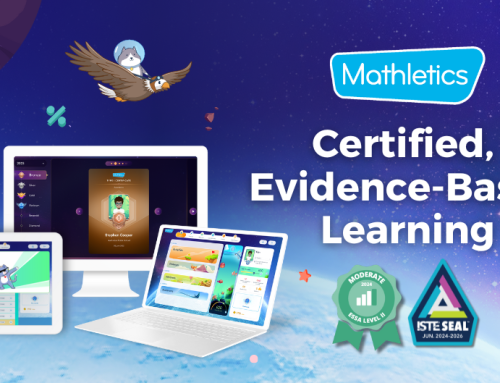It’s important for students to receive immediate feedback on their daily and formative work, as part of their learning process.
But how can we create differentiated learning opportunities for a class of 30 students and ensure that learning and growth are happening consistently for every student?
This is where online educational programs can help.
In a recorded interview with Joe Marquez, Director of Academic Innovation at CUE.org, Sheila Robitaille, one of our Professional Learning Specialists, shares powerful features in Mathletics that make differentiation easy and fast.
We unpacked three key takeaways from their conversation.
1. Create multiple student learning groups in seconds
As teachers, we need to know which students need that extra scaffold to be able to lift them up.
Mathletics makes this possible by enabling teachers to create different learning groups. Sheila, who is also a veteran educator with 30 years of experience in education, demonstrates this with a scenario.
Say you are teaching a Grade 3 class and right now your class has been set up nicely in your Mathletics Teacher Dashboard. You notice two students, let’s call them Isaac and Albert, who have some learning gaps and are operating on a lower grade level. And you wish to assign only Grade 2 questions to only Isaac and Albert.
Creating a new learning group in Mathletics is simple.
Head over to ‘Groups’, click ‘New Group’ and assign the group a name. Then hit the ‘Save’ button. Next, go to the two students Isaac and Albert, and change their default level to this new group that you’ve created. Now when either Issac or Albert log into Mathletics, they’re going to be getting content that suits their learning level.
Your differentiated learning is done with just a few clicks of a button.
If you’re worried that Isaac or Albert might find out that they are on a lower level compared to their peers, the program is inclusive and considers this by ensuring students never see the groups they are allocated to.
Over time, when Isaac and Albert progress and they’re ready to rejoin the class, you can come back to your Teacher Dashboard and place them back in the default class group.
The power of Mathletics’ differentiation feature is that it gives you the flexibility and accessibility to group students according to their level in a fast and easy way, something you can’t do with worksheets.
You can also apply this feature to students who have shown mastery and require content that is more challenging, by grouping them above their grade level so they can advance at their pace.
We understand that there are students with diverse abilities and levels within a class. That’s why you can set up to 12 different learning groups in each class.
Watch the the demonstration below to see how you can do all the above in Mathletics.
2. Provides data-driven decisions for better intervention
In Mathletics, questions are also adaptable.
If your student is getting question after question after question right, then the level of challenge goes up. They will receive the same types of questions but get a different set of questions. This ensures that they are not just memorizing the answers, but that actual learning is occurring and they are demonstrating additional mastery.
When students get several questions wrong in a row, the program will start to adapt the questions to get them back to their level.
And if they want to re-attempt an activity again to see if they can improve their scores, they can easily jump back into their Student Console and do it on their own. Once students have completed their assigned work in Mathletics, teachers can use the data to make decisions about what to do next within a class period.
The ‘Assign and Review’ area is where you can find all your students’ scores for any assigned activities.
The red, blue and green boxes tell you how each student is performing at a glance.
Red box: This means students need more support. You may want to pull these students aside to work with them on the topic and find out what difficulties they’re having in this area.
Blue box: This means students are developing their understanding. Challenge them to go back and redo the activity and see if they can improve their scores.
Green box: This means students have demonstrated mastery. You could have a separate enrichment activity for them because they’ve already demonstrated mastery, or you could assign them a second activity to work on within the program as well.
Watch the video below to learn what you can do in our ‘Assign and Review’ area.
3. Fill learning gaps quickly and accurately
Have you ever graded a mathematics assessment on Friday and spent hours making personalized learning plans for each student over the weekend? What if there was a quicker way of doing this?
The digital assessments and ‘Fill learning gaps’ tools in Mathletics allow you to do all the above, minus the hours it can take.
The ‘Assessment’ area enables you to provide differentiated learning for each student by providing specific intervention activities, based on their strengths and their weaknesses.
To assign Mathletics Assessments to students, simply select the curriculum, the state, or the provincial curriculum that you’re working with. Once your class has completed the assessment, you can immediately see their overall marks.
So, what should you do next? This is where Mathletics ‘Fill learning gaps’ really shines.
When teachers click into the ‘Fill Learning Gaps’ feature, it looks at each student and suggests additional Mathletics content for practice. These recommendations are based on each individual student’s assessment responses.
When you hover over the recommended content, you can see why the program is prescribing specific content to that student; it’s because he or she got a certain question wrong in the assessment.
For example, if a student answers a question about time incorrectly, the program knows that the student could need more practice and suggests a relevant activity about time to fill in any learning gaps. The best part is, you can assign these intervention tasks immediately in the same dashboard and move on to the next student.
Watch the video below to see how you can quickly do this in Mathletics.
Differentiated Learning Made Easy with Mathletics
There’s nothing more frustrating to a student than going through question after question, getting it wrong and not receiving help. Or a student getting restless because they’re not challenged enough.
Differentiated learning helps build and nurture a growth mindset in students as it makes them feel like they are accomplishing something in class. And this creates a sense of community in the classroom because everybody’s learning.
Mathletics is not just a powerful differentiated learning resource to help create a personalized learning space; it is a classroom tool that collaborates with the educator.
Best of all, it gives you time to let you focus on what you do best – making connections with your students and empowering them in their learning journey.








